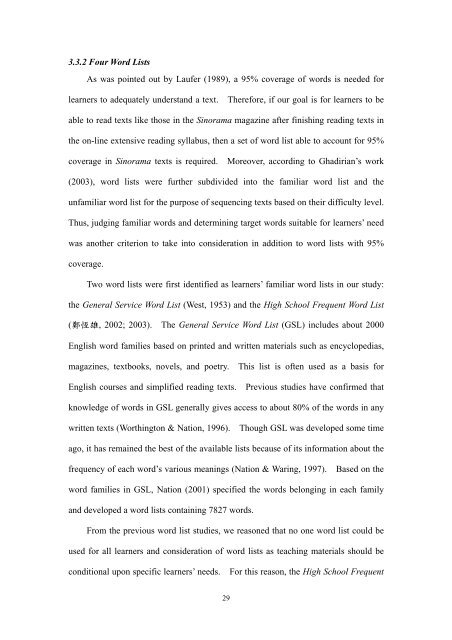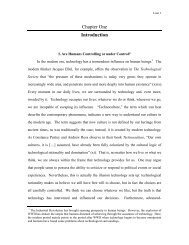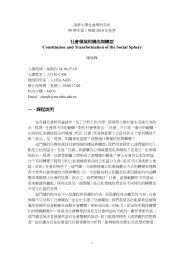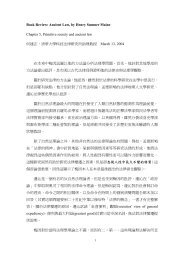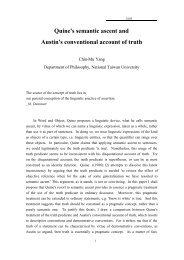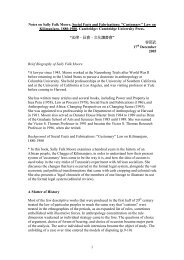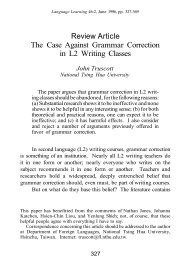Effects of Graded Texts on EFL College Students' Incidental ...
Effects of Graded Texts on EFL College Students' Incidental ...
Effects of Graded Texts on EFL College Students' Incidental ...
Create successful ePaper yourself
Turn your PDF publications into a flip-book with our unique Google optimized e-Paper software.
3.3.2 Four Word Lists<br />
As was pointed out by Laufer (1989), a 95% coverage <str<strong>on</strong>g>of</str<strong>on</strong>g> words is needed for<br />
learners to adequately understand a text. Therefore, if our goal is for learners to be<br />
able to read texts like those in the Sinorama magazine after finishing reading texts in<br />
the <strong>on</strong>-line extensive reading syllabus, then a set <str<strong>on</strong>g>of</str<strong>on</strong>g> word list able to account for 95%<br />
coverage in Sinorama texts is required. Moreover, according to Ghadirian’s work<br />
(2003), word lists were further subdivided into the familiar word list and the<br />
unfamiliar word list for the purpose <str<strong>on</strong>g>of</str<strong>on</strong>g> sequencing texts based <strong>on</strong> their difficulty level.<br />
Thus, judging familiar words and determining target words suitable for learners’ need<br />
was another criteri<strong>on</strong> to take into c<strong>on</strong>siderati<strong>on</strong> in additi<strong>on</strong> to word lists with 95%<br />
coverage.<br />
Two word lists were first identified as learners’ familiar word lists in our study:<br />
the General Service Word List (West, 1953) and the High School Frequent Word List<br />
(鄭恆雄, 2002; 2003). The General Service Word List (GSL) includes about 2000<br />
English word families based <strong>on</strong> printed and written materials such as encyclopedias,<br />
magazines, textbooks, novels, and poetry. This list is <str<strong>on</strong>g>of</str<strong>on</strong>g>ten used as a basis for<br />
English courses and simplified reading texts. Previous studies have c<strong>on</strong>firmed that<br />
knowledge <str<strong>on</strong>g>of</str<strong>on</strong>g> words in GSL generally gives access to about 80% <str<strong>on</strong>g>of</str<strong>on</strong>g> the words in any<br />
written texts (Worthingt<strong>on</strong> & Nati<strong>on</strong>, 1996). Though GSL was developed some time<br />
ago, it has remained the best <str<strong>on</strong>g>of</str<strong>on</strong>g> the available lists because <str<strong>on</strong>g>of</str<strong>on</strong>g> its informati<strong>on</strong> about the<br />
frequency <str<strong>on</strong>g>of</str<strong>on</strong>g> each word’s various meanings (Nati<strong>on</strong> & Waring, 1997). Based <strong>on</strong> the<br />
word families in GSL, Nati<strong>on</strong> (2001) specified the words bel<strong>on</strong>ging in each family<br />
and developed a word lists c<strong>on</strong>taining 7827 words.<br />
From the previous word list studies, we reas<strong>on</strong>ed that no <strong>on</strong>e word list could be<br />
used for all learners and c<strong>on</strong>siderati<strong>on</strong> <str<strong>on</strong>g>of</str<strong>on</strong>g> word lists as teaching materials should be<br />
c<strong>on</strong>diti<strong>on</strong>al up<strong>on</strong> specific learners’ needs. For this reas<strong>on</strong>, the High School Frequent<br />
29


